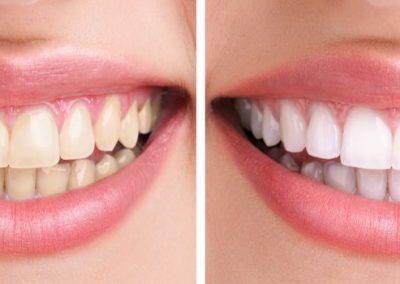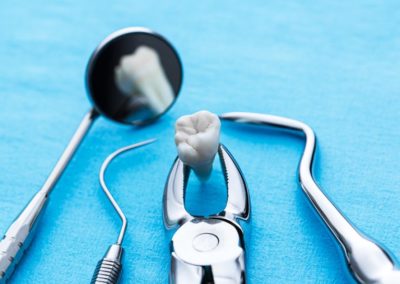Crowns & Bridges
What is a dental bridge?
A bridge is a special dental apparatus that spans, or bridges, the gap made by one or more teeth that have fallen out or been extracted. Bridges rest on the teeth on either side of the gap, which are usually protected by strong dental crowns, coverings that surround an entire tooth to provide strength.
While in the past dental bridges and removable dentures were the only option to replace missing teeth with progress in implant dentistry now patients and dentists have many options including implant crowns and implant bridges to replace a single missing tooth to multiple teeth, and implant dentures for a full mouth reconstruction. If you would like to know when dental implant restorations are a better option please visit Implant Dentistry.
What should I expect during a bridge procedure?
Bridges usually take two visits to complete. In the first visit, the teeth on either side of the gap will be shaped to make room for crowns, and an impression will be made of the gap so the bridge can be made to fit. Temporary crowns will be placed on the teeth to protect them while your bridge and crowns are being made. At the second visit, the crowns will be placed on your teeth using a strong adhesive and the bridge will be attached as well. Fixed bridges are permanently attached to the crowns using a bonding adhesive while removable bridges attach using clips.
What is a Dental Crown?
A dental crown, also known as porcelain crown or ceramic crown is a dental restoration fabricated outside of patients in the laboratory settings by a technician. A dental crown can be made out of different materials like gold, ceramic, porcelain fused to metal.
The dental crown procedure, however, is performed by a licensed dentist and requires significant skills. During the preparation process, the dentist will remove some of the tooth structure across the entire tooth to accommodate the new dental crown. Any compromised tooth structure, like decay or cracks, is also removed during dental crown prep.
Dental crown procedure
Porcelain crown procedure is a two-visit treatment identical to that of ceramic onlay and inlay. If you are interested detailed description of the process, please check out ur Porcelain & Composite Fillings article.
Temporary dental crowns are inserted upon completion of the prep. They will last until the cementation of the permanent crown.
Types of Dental Crowns
- All ceramic crowns, like eMax press
- Zirconia crowns
- Porcelain fused to metals crowns
- Gold crowns
The types of the dental crowns, in reality, describe the types of materials used to fabricate the crown but the concept and the process from the patient’s stand point is the same.
“Tooth Enamel is a translucent surface that can transmit up to 70% of light. Dentin can also transmit some of the light”,- as described in the Open Dentistry Journal. So when a dental crown is diagnosed the position of the tooth, the bite and aesthetics have to be considered when choosing the right type of dental crown. The most popular type of dental crowns currently are Zirconia, and Emax Press crowns. They are metal free caps that have beautiful aesthetics and longevity.
Dental crown on the back teeth
Zirconia crowns are more opaque than eMax caps, but if you are bruxer, it might be a better choice.
Dental crowns for the front teeth
If you need dental crowns on front teeth and you are not a grinder eMax crowns offer very natural looking option to restore your teeth.
At 209 NYC Dental, we work with top of the line dental lab and ceramic specialist, which ensures that our results are beautiful and natural looking teeth. Check out our smile gallery of dental crowns before and after photos to judge for yourself.
When do I need a dental crown?
With so many options to restore damaged teeth, it is important to understand what is the proper treatment for each type of the dental damage. In the dental arsenal of procedures, we have dental bondings, ceramic onlays and inlays, dental crowns, and porcelain veneers to restore most of the damage caused by decay or fractures or to enhance one’s smile.
In the porcelain and composite fillings, we discuss in detail when it is more appropriate to restore the tooth with dental bondings or porcelain onlays, in porcelain veneers article you can find a detailed explanation when dental veneersare considered the best treatment. Here we would like to review the circumstances when a dental crown procedure is required.
Reasons to restore the tooth with dental crown:
- If you need a Root Canal or had a root canal treatment done, it is advised to reconstruct the tooth with a porcelain crown. After root canal procedure the tooth becomes brittle and may break under biting pressure. Thus promptly restoring it with a crown is suggested.
- If the tooth is significantly broken and a porcelain onlay may not obtain proper retention to provide a long lasting result, the dentist will recommend placing a crown over the broken tooth.
- If there is an old crown that needs to be replaced due to fracture, or decay, or due to cosmetic reasons, a new crown will be required to replace the old one.
Dental crown vs. onlay
Similarities:
- Both dental treatments reconstruct damaged teeth
- Both have the same preparation and delivery process, see below
- Crowns and onlays can be made of the same material, ceramic or gold
- The cost of the treatment is comparative
Differences:
- The size and the amount of tooth filed down to accommodate the new restoration is the biggest difference between the two.
Dental crown problems:
- With significant advancements in ceramic dentistry, dental crowns are a less needed treatment than it used to be. Due to a significant reduction in tooth structure, it is not as desired of the procedure anymore, since ceramic onlays and inlays provide the same type of restoration while being a more conservative treatment that does not require the same reduction of the tooth.
- If the crown is a porcelain fused to metal, eventually the metal edge of the crown starts to show and if aesthetics is important the replacement of the crown will be required
- Just like any restoration because of various reasons a dental cap may come off.
What to do if dental crown fell off?
Is this a dental emergency? Yes, it is? Do you have to be seen right away? What to do if you have no access to the dentist?
If dental crown falls off, you absolutely have to see a dentist to check the tooth, clean the crown and re-cement it with permanent cement if there are no contradictions.
If you are away, or it is a Sunday, it is not an emergency that has to be addressed immediately, unless you are in pain. You can buy a temporary over the counter cement in the nearest pharmacy and temporary cement the crown. Please remember, it is only a temporary solution. Temporary cement does not provide a proper sterile environment that tooth requires not to get decayed again. In addition, there might be an underlying reason why the crown came off, and if not resolved right away it may cause more toothache and expense in the future.
Dental cap vs. crown
The two terms mean the same. The phrase dental cap is a colloquialism that was derived from a phrase “dental crown caps the tooth.”
Dental implant vs. crown
These two procedures are not alternatives to each other under any circumstances. A dental crown restores an existing tooth, while dental and implant crown restores a missing tooth. If you want to save a tooth that has a questionable diagnosis and you were told that your options are a root canal, post /core, and a dental crown, or extraction, dental implant, and implant crown we would suggest considering finances. If you choose option one, and the tooth still will require extraction you will end up paying for both treatments. If the finances are not a concern, having your own tooth is always a plus.
Schedule your next appointment!















